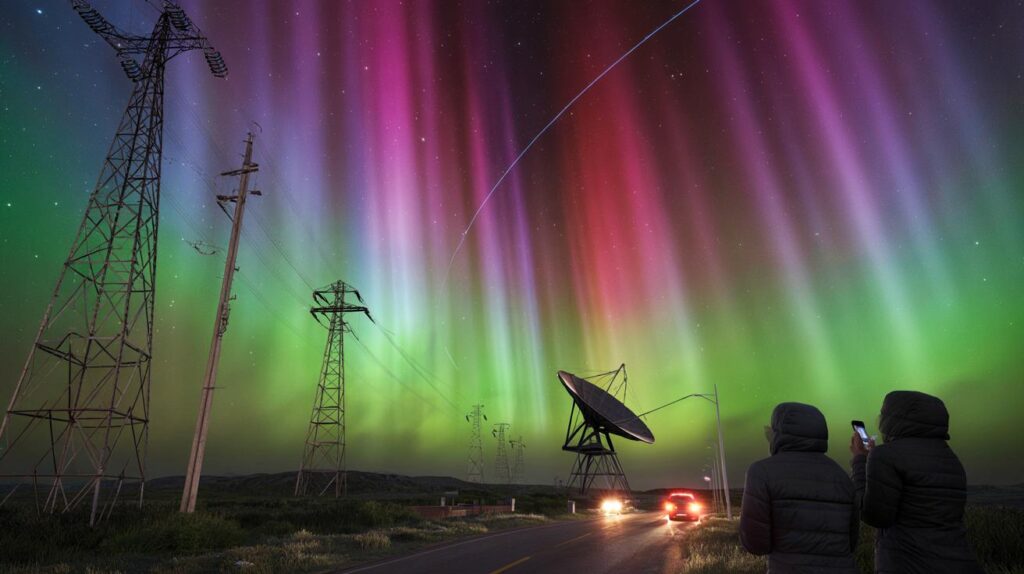A wave of solar-charged particles is disturbing Earth’s magnetic shield, sending restless energy through the upper atmosphere while instruments click and hiss. NASA teams are monitoring the ionosphere closely, as power-grid operators and pilots quietly enter a state of caution.
m., neck stretched, when the sky changed to the hue of a bruised plum and the streetlights appeared suddenly diminutive. Cars remained stationary with their headlights off, people whispering as if they had entered a cathedral. Someone raised a phone and the compass app flickered, then froze, then snapped back.
Above, the atmosphere was interwoven with invisible threads, softly humming in a cosmic tone we often overlook. *For a moment, I could swear the air itself vibrated.* The dog across the street remained silent. A satellite traced a cold path overhead. The sky felt electrified.
When the sky hums: what NASA is observing right now
Currently, Earth is being grazed by a rapid stream of solar-charged particles and the remnants of recent coronal mass ejections. These particles do not crash to the ground; they twist our magnetic field, creating **ionospheric electrojets** that race thousands of kilometers above us. The outcome is electricity in unexpected places—radio static, navigation drift, and the auroras that beckon us from our beds.
During the headline-grabbing G5 storm in May, auroras descended to latitudes that seldom experience them. Airlines adjusted **polar flight routes** southward to maintain clear communication, and magnetometers on the ground registered in the red. Amateur radio operators reported dead zones, followed by sudden, eerie clarity as layers of the ionosphere snapped and flexed. NASA’s fleet observed the ionosphere spike and sag—fine-structure ripples resembling a heartbeat under pressure.
Here’s the straightforward physics: the Sun ejects a blob of magnetized plasma, it collides with our magnetosphere, and currents emerge as the system strives for equilibrium. These currents connect the sky and the ground, generating **geomagnetically induced currents (GICs)** that can infiltrate long power lines and pipelines. That’s the “dangerous” aspect of the headline—risk to infrastructure—while the air you breathe remains safe. On the ground, your body is not a target. Your grid might be.
What you can do, from the ground up
Keep it straightforward: during a significant geomagnetic alert, unplug your most sensitive devices overnight and allow large appliances to rest. Download offline maps in case GPS behaves erratically for a day. If you depend on satellite timing for work—finance timestamps, farm autosteer, survey drones—plan for a buffer window and verify against an independent clock.
Let’s be honest: no one really does this every day. So establish habits you can actually maintain. Sign up for NOAA’s space weather alerts, or follow a single trusted account that posts when the Kp index rises. Inform a friend who lives far north or south that auroras might appear, and reassure a relative who worries that this isn’t a doomsday narrative. We’ve all experienced that moment when a headline grabs our attention.
As one experienced space weather forecaster told me,
“The Sun isn’t angry. It’s just active. Our job is to be prepared when the lights attempt to flicker.”
If you prefer a quick-start guide, here’s a handy checklist to reduce the noise:
- Use surge protectors on desktops and home servers.
- Keep a small battery pack charged for your phone and modem.
- Save offline maps and important documents before major storms.
- If you fly or sail, practice HF/VHF communication backups.
- For critical tasks, log timestamps from two independent sources.
Where this leaves us
We exist beneath a magnetic umbrella woven by a star that forgets to be quiet. Some nights it gifts us curtains of light and strangers on sidewalks. Other days it probes the delicate aspects of our modern existence—thin wires, satellites, and the global clock we share. The same physics that colors the sky is the one that can jolt a transformer halfway across a continent.
NASA, NOAA, and partners keep vigil, mapping the unseen with satellites and ground sensors so most of us hardly notice. That’s the quiet miracle here. The next storm might be brighter, messier, or just a faint whisper you only perceive when your GPS takes one beat too long. Perhaps this is less about an apocalypse, and more about learning to coexist with a star—and learning to heed when the sky hums.
| Key Point | Detail | Reader Interest |
|---|---|---|
| Space weather is electrical | Solar storms generate currents in the ionosphere and weak ground currents | Explains why radios, GPS, and power grids can behave unusually |
| NASA is tracking the spikes | Satellites and ground arrays monitor ionospheric “disturbances” in real time | Provides context and reassurance: someone is monitoring the gauges |
| Small actions help | Protect electronics, plan timing buffers, follow alerts | Transforms a frightening headline into practical steps you can take |
FAQ :
- Is there really a “deadly current” in the atmosphere?This phrase is exaggerated. The currents above are real and powerful, but they don’t “zap” individuals on the ground. The greater risk is indirect—surges in long power lines, timing errors, and satellite strain.
- Could my phone or car be damaged by this?Very unlikely. Household-scale devices are short; GICs prefer long conductors such as high-voltage lines and pipelines. Use a good surge protector and unplug sensitive devices during significant alerts for peace of mind.
- Why is this happening now?We are nearing the peak of Solar Cycle 25. More sunspots lead to more flares and coronal mass ejections, which disturb Earth’s magnetic field and energize the ionosphere.
- How do scientists measure “electrical disturbances” overhead?Using magnetometers, ionosondes, GPS total electron content maps, and satellites that track particle flows and fields. They observe how the ionosphere’s density and currents change hourly.
- Will we see auroras again soon?Chances increase when strong storms are predicted. Check NOAA’s 3-day Kp index and local aurora trackers. If the numbers rise and clouds cooperate, step outside and look north or south from dark areas.








